How To Find An Ip Address On Iphone
How would you communicate with a device when you don't have the IP?
You might exist in a state of affairs where yous don't have the IP address of a device in a local network, merely all you take is records of the MAC or hardware address.
Or your computer is unable to display its IP due to various reasons, and you are getting a "No Valid IP Address" mistake.
Finding the IP from a known MAC address should be the chore of a ReverseARP application, the counterpart of ARP. Merely RARP is an obsolete protocol with many disadvantages, then information technology was rapidly replaced by other protocols similar BOOTP and DHCP, which deal straight with IP addresses.
In this article, we'll bear witness you how to detect all ip addresses on a network along with device vendors using MAC addresses with different methods for gratuitous.
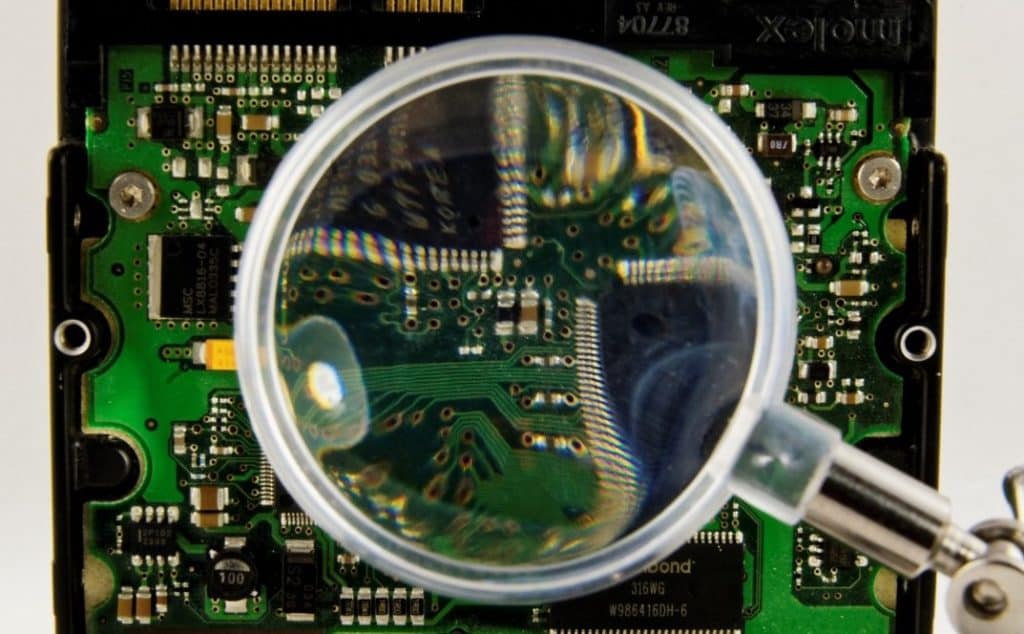
Related post: How to Browse network for IP Addresses
Understanding ARP
ARP (Accost Resolution Protocol) is the protocol in charge of finding MAC addresses with IPs in local network segments.
It operates with frames on the data link layer. As you lot might already know, devices in the data link layer depend on MAC addresses for their communication. Their frames encapsulate packets that contain IP accost information.
A device must know the destination MAC address to communicate locally through media types like Ethernet or Wifi, in layer 2 of the OSI model. Agreement how ARP works can assist you lot detect IPs and MAC addresses rapidly.
The following message menses diagram can help y'all understand the concept:
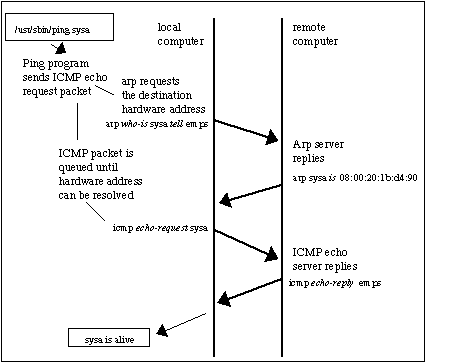
- The local computer sends a ping (ICMP echo request) to a destination IP address (remote computer) within the aforementioned segment. Unfortunately, the local figurer does not know the MAC address… it simply knows the IP accost.
- The destination hardware address is unknown, so the ICMP echo asking is put on concur. The local computer only knows its source/destination IP and its source MAC addresses. ARP uses two types of messages, ARP Request and Respond.
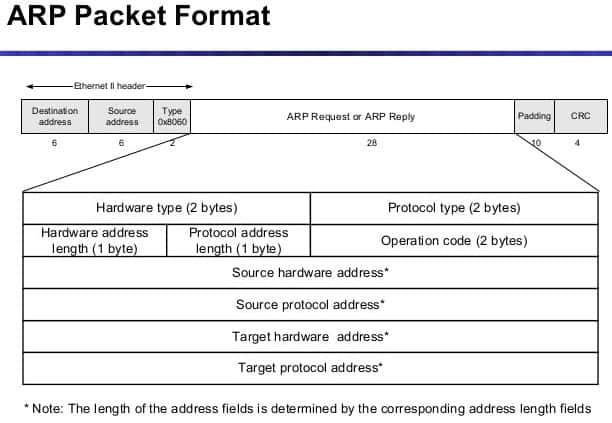
The local computer sends an ARP Request message to find the owner of the IP address in question.
This message is sent to all devices within the same segment or LAN through a broadcast MAC (FF:FF:FF:FF:FF:FF) equally the destination.
- Considering the remote calculator is part of the aforementioned network segment, information technology receives the circulate message sent past the local computer. All other computers in the LAN also receive the broadcast only they know that the destination IP is not theirs, so they discard the bundle. Only the remote estimator with destination IP, responds to the ARP Asking with an ARP REPLY, which contains the target MAC address.
- The local computer receives the ARP Reply with the MAC address. It then resumes the ICMP echo asking, and finally, the remote computer responds with an ICMP repeat respond.
Finding IPs with ARP
You can use ARP to obtain an IP from a known MAC address.
Only first, information technology is important to update your local ARP table in society to get information from all devices in the network.
- Send a ping (ICMP repeat reply) to the entire LAN, to get all the MAC entries on the table.
- To ping the entire LAN, you tin can send a broadcast to your network.
- Open the Command Prompt in Windows or terminal in macOS and type.
ping 192.168.0.255
My subnet is 192.168.0.0/24 (mask of 255.255.255.0), so the broadcast address is 192.168.0.255 which can exist calculated or found with a "Impress Route" command in Windows or a "netstat -nr" in macOS. Or can also be obtained with a subnet calculator that you can download for free.
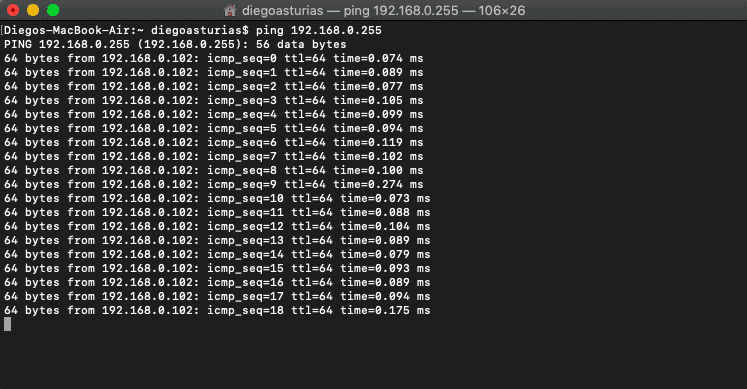
For Windows:
Step i
- Open the CMD (Control Prompt)
- Go to the "Starting time" carte and select "Run" or printing [Windows-fundamental] + [R] to open up the Run awarding
- In the "Open" textbox type "cmd" and press "OK".

This volition open the command-line interface in Windows.
Pace ii
- Enter the "arp" command.
- The arp command without any additional arguments volition requite you a list of options that you lot tin can use.
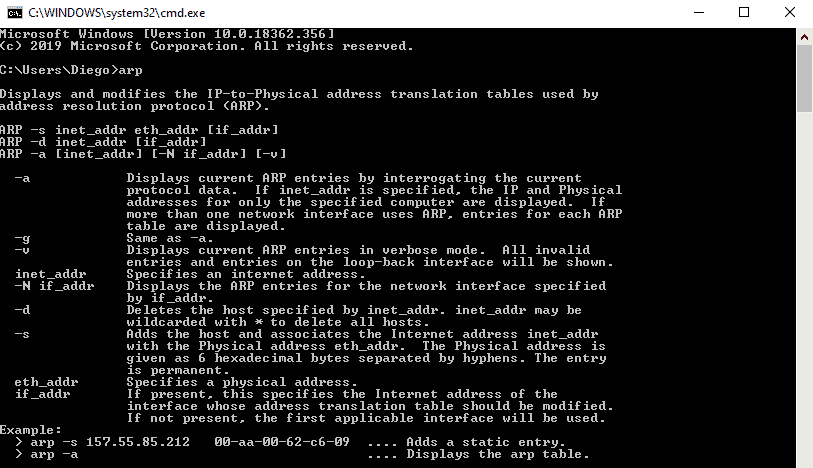
Step 3
- Employ the arp with additional arguments to find the IP within the same network segment.
- With the control "arp -a" you tin encounter the ARP tabular array and its entries recently populated past your computer with the broadcast ping.
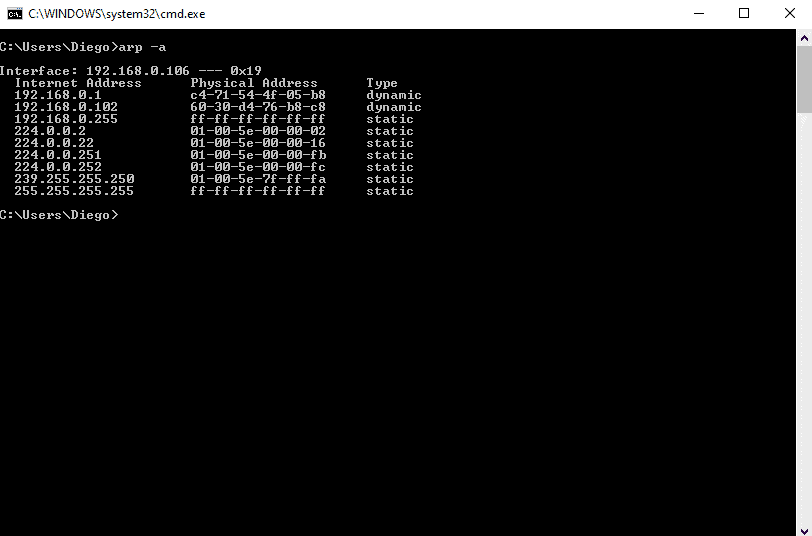
Step iv.
- Reading the output.
- The information displayed in the arp-a is basically the ARP tabular array on your calculator.
- It shows a list with IP addresses, their corresponding physical address (or MAC), and the type of allocation (dynamic or static).
Permit's say you lot have the MAC accost lx-30-d4-76-b8-c8 (which is a macOS device) and you want to know the IP.
From the results shown above, you tin map the MAC accost to the IP address in the same line.
The IP Address is 192.168.0.102 (which is in the same network segment) belongs to threescore-thirty-d4-76-b8-c8.
You tin can forget about those 224.0.0.10 and 239.0.0.x addresses, every bit they are multicast IPs.
For macOS:
Step 1
- Open up the Terminal App. go to Applications > Utilities > Last or Launchpad > Other > Terminal.
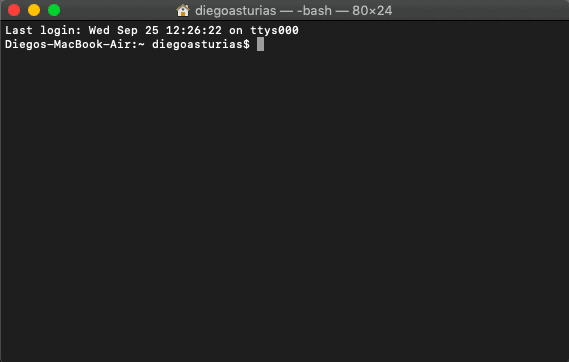
Step ii
- Enter the "arp" command with an "-a" flag.
- Once you lot enter the command "arp -a" y'all'll receive a list with all ARP entries to the ARP Table in your calculator.
- The output will prove a line with the IP accost followed by the MAC accost, the interface, and the allocation type (dynamic/static).

Finding IPs with the DHCP Server
The Dynamic Host Configuration Protocol (DHCP) is the network protocol used by TCP/IP to dynamically allocate IP addresses and other characteristics to devices in a network. The DHCP works with a customer/server mode.
The DHCP server is the device in charge of assigning IP addresses in a network, and the client is usually your estimator.
For abode networks or LANs, the DHCP Server is typically a router or gateway.
If you take access to the DHCP Server, you can view all relationships with IPs, MACs, interfaces, name of the device, and lease fourth dimension in your LAN.
Stride one
- Log into the DHCP Server. In this example, the DHCP server is the home gateway.
- If you don't know the IP address of your DHCP Server/ Gateway, you can run an ipconfig (in Windows) or ifconfig (in macOS/Linux)
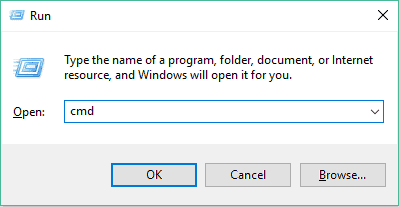
- This particular DHCP Server/Gateway has a web interface.
Step 2
- Enter the IP address on the search bar of the web browser, and input the correct credentials.
Step iii
- Find the DHCP Clients List.
- In this TP-Link router, the DHCP Server functionality comes as an additional feature.
- Go to DHCP > DHCP Clients Listing. From this listing, y'all tin see the mapping between MAC addresses and their assigned IPs.
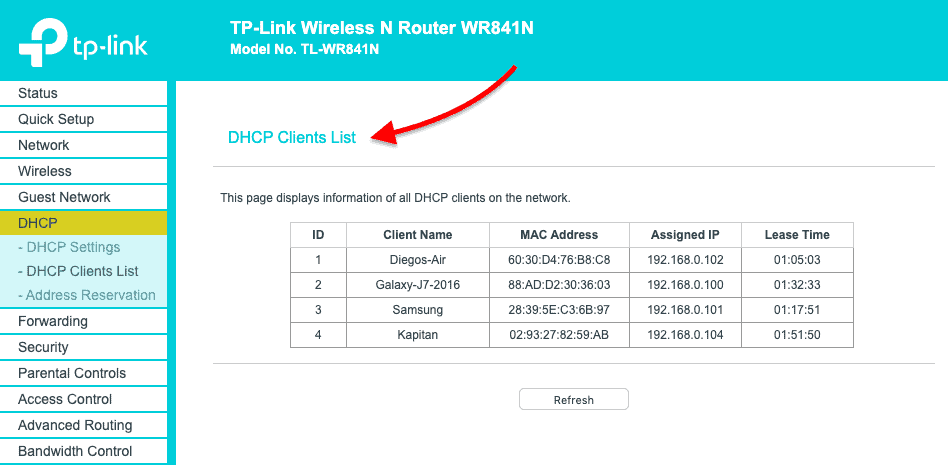
Using Sniffers – Nmap
If you lot couldn't find the IP in the ARP list or unfortunately don't accept admission to the DHCP Server, as a concluding resort, you can use a sniffer.
Packet sniffers or network analyzers like Nmap (or Zenmap which is the GUI version) are designed for network security.
They can help identify attacks and vulnerabilities in the network.
With Nmap, you lot tin actively scan your entire network and find IPs, ports, protocols, MACs, etc.
If you are trying to notice the IP from a known MAC with a sniffer similar Nmap, look for the MAC address inside the scan results.
How to find the Device and IP with a Sniffer?
Step 1
- Go on records of your network IP address information.
- In this instance, my network IP is 192.168.0.0/24. If you don't know it, a quick "ipconfig" in Windows cmd or an "ifconfig" in macOS or Linux terminal can show you lot the local IP and mask.
- If y'all can't subnet, Download this Costless Subnet Calculator tool or go online to a subnet calculator and observe your network IP.
Step 2
- Download and open Nmap.
- Download Nmap from this official link https://nmap.org/download.html and follow its straightforward installation process.
Step 3
- Open Nmap (or Zenmap) and use the control "sudo nmap -sn (network IP)" to scan the entire network (without port scan).
- The command will list machines that respond to the Ping and will include their MAC accost along with the vendor.
- Don't forget the "sudo" command.
- Without it, you will not see MAC addresses.
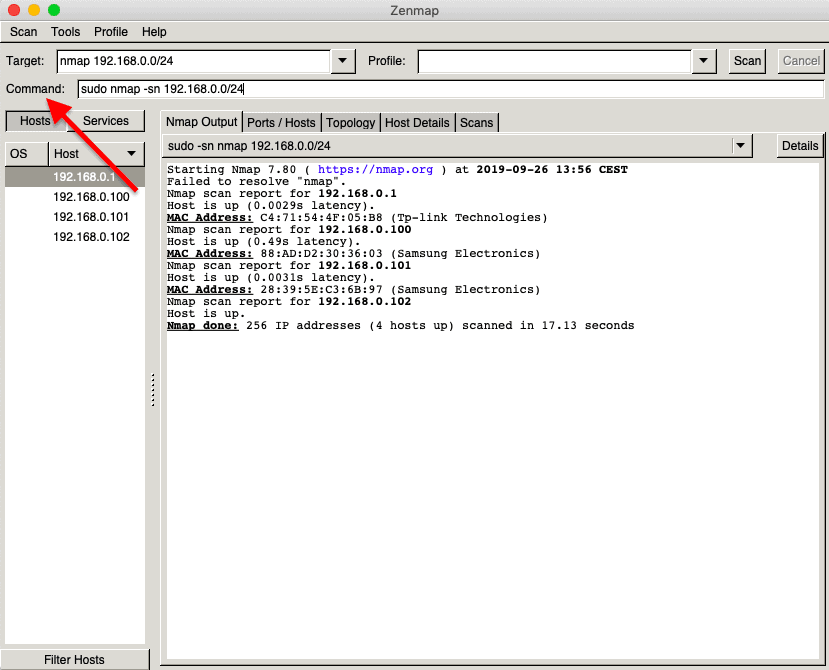
Finding out the device vendor from a MAC address
Ok, then now you were able to observe out the IP address using "arp -a" command or through the DHCP Server.
But what if y'all want to know more details about that item device?
What vendor is information technology?
Your network segment or LAN might be total of dissimilar devices, from computers, firewalls, routers, mobiles, printers, TVs, etc.
And MAC addresses contain cardinal data for knowing more details about each network device.
First, it is essential to sympathise the format of the MAC address.
Traditional MAC addresses are 48 $.25 represented in 12-digit hexadecimal numbers (or six octets).
The outset half of the six octets stand for the Organizational Unique Identifier (OUI) and the other half is the Network Interface Controller (NIC) which is unique for every device in the globe.
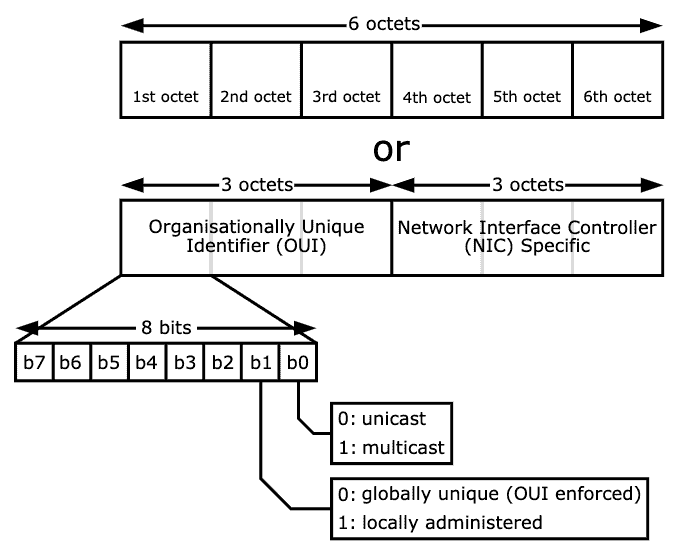
There is not much nosotros can do nearly the NIC, other than communicating with it.
But the OUI tin can give us useful information about the vendor if you lot didn't employ Nmap, which can besides give you the hardware vendor.
Using Wireshark OUI Lookup
A free online OUI lookup tool like Wireshark OUI Lookup tin help you lot with this.
Just enter the MAC accost on the OUI search, and the tool volition wait at the first three octets and correlate with its manufacturing database.
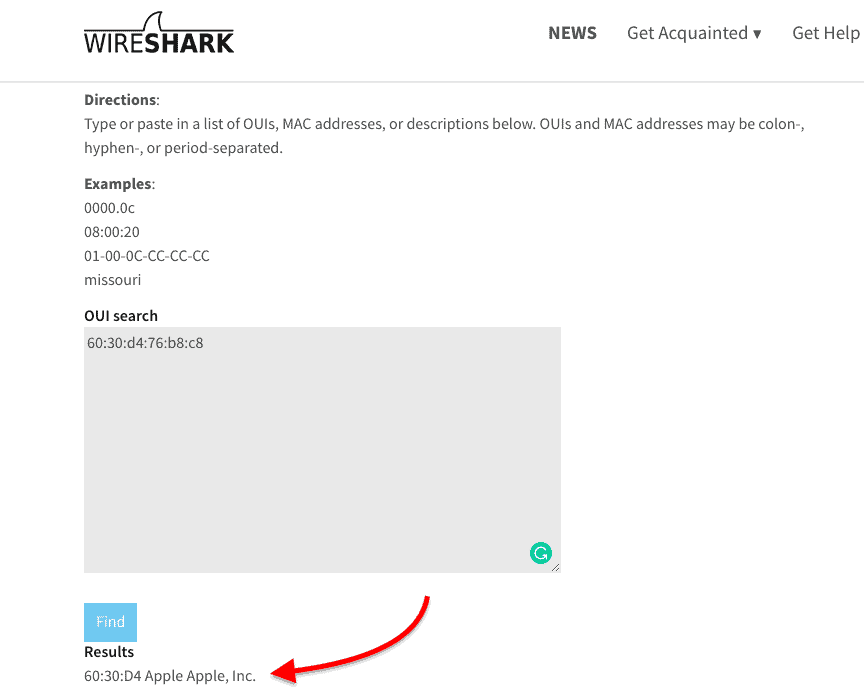
Using DHCP to view IP info
Although the RARP (the analogue of ARP) was specifically designed to find IPs from MAC addresses, it was quickly discontinued because it had many drawbacks.
RARP was quickly replaced past DHCP and BOOTP. But ARP is even so one of the core functions of the IP layer in the TCP/IP protocol stack. It finds MAC addresses from known IPs, which is most common in today'southward communications. ARP works under the hood to keep a oftentimes used list of MACs and IPs.
Simply you tin too use it to meet the electric current mappings with the control arp -a.
Aside from ARP, you can also use DHCP to view IP information. DHCP Servers are usually in charge of IP assignments. If you have access to the DHCP server, become into the DHCP Client list and place the IP with the MAC address. Finally, you tin can utilise a network sniffer like Nmap, scan your unabridged network, and detect IPs, and MACs.
If you only want to know the vendor, an online OUI lookup like Wireshark can assistance you lot observe it rapidly.
Notice a Device or IP Accost FAQs
Tin you find an IP address from a MAC accost?
Yep. Open a Command Prompt window and enter the command arp -a. The output shows all of the IP addresses that are active on your network. The next column in the output is headed Physical Accost. This is the MAC address. Look for the line in the output that has the MAC address that y'all know and note down the IP address on that line.
How can I access a device past MAC accost?
The easiest way to admission a device, knowing the MAC accost is to use the arp -a command to find the related IP address. With this accost, you lot tin access the device using Remote Desktop Management, a Telnet program, or some other connexion facility.
How tin can I find a device by IP accost? (cmd instructions)
You can follow a path to a device if you know its IP address past using the tracert control at the command prompt (cmd). Open a Command Prompt window and type in tracert followed by the IP address that you know. The output will show each router that has a connection to that device will pass through.
Source: https://www.pcwdld.com/find-device-or-ip-address-using-mac-address
Posted by: ungerloped1957.blogspot.com


0 Response to "How To Find An Ip Address On Iphone"
Post a Comment